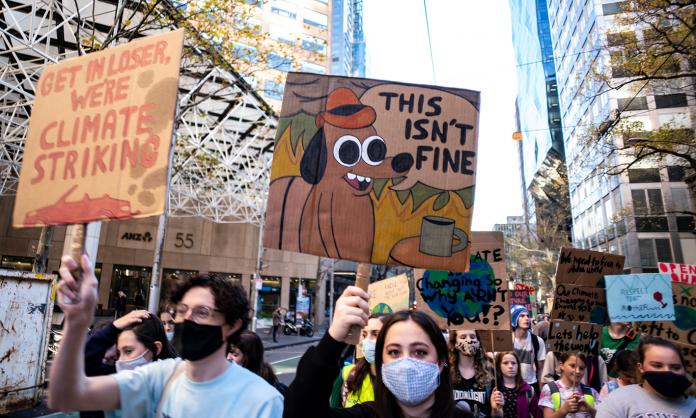The climate movement, in Australia at least, seems to have arrived at an impasse. While thousands of high school students and their supporters took to the streets for the latest round of School Strike 4 Climate (SS4C) rallies on 21 May, the turnout was significantly lower than the last round of actions. In September 2019, 300,000 marched at rallies around Australia. In Melbourne, more than 100,000 turned out. This time, the Melbourne rally attracted less than 10,000, Sydney got around 5,000, while Brisbane, Adelaide and Perth all got less than 1,000.
This isn’t because those fighting for real action on climate change are making gains. The policies of the governing Coalition and the “opposition” Labor Party remain appalling. Morrison and Co. are laying the basis for a “gas-fired recovery” that will lock-in Australia’s role as one of the world’s worst climate criminals for decades to come. Labor, in appealing to pro-coal constituencies in areas such as the NSW Hunter Valley and north Queensland, isn’t even pretending to take the issue seriously.
An Australia Institute report released in April, Fossil fuel subsidies in Australia, found that federal and state subsidies to the fossil fuel industry amounted to $10.3 billion in 2020, or $19,686 a minute. Labor-run states such as Queensland, Western Australia and Victoria have been just as enthusiastic in supporting the fossil fuel industry. The Victorian government, for example, is “spending $8.8 million to restart an onshore gas industry and develop a ‘gas roadmap’, spending dwarfed by the $100 million going to turn brown coal into hydrogen and export it to Japan”.
All this is far from the three demands of SS4C: no new coal and gas projects, including the Adani mine, 100 percent renewable energy generation and exports by 2030, and funding for a just transition and job creation for all fossil fuel workers and communities.
Greta Thunberg, who inspired the global school strike for climate movement, said in a speech to the US Congress two years ago: “This is not the time and place for dreams. This is the time to wake up. This is the moment in history when we need to be wide awake ... We need dreams, [but] dreams cannot stand in the way of telling it like it is”.
Being wide awake means recognising that we’re staring down the barrel of years, if not decades, of government inaction. And even this is to put a somewhat optimistic spin on things. More accurately, we might say that instead of mere inaction, what we’re getting is government action to preserve Australia’s fossil fuel economy.
The consequences of this will be catastrophic. The summer of 2019-20 gave us a glimpse of what life on a “hothouse Earth” will look like. But if scientists’ predictions of what will happen if we fail to rapidly bring down emissions over the next decade turn out to be true, we should amplify the apocalyptic scenes of devastation of Australia’s bushfire catastrophe by ten or more to get a true picture of the future that awaits us.
In her speech to the US Congress, Thunberg complained: “Wherever I go, I seem to be surrounded by fairy tales. Business leaders, elected officials all across the political spectrum spending their time making up and telling bedtime stories that soothe us, that make us go back to sleep”. In a 2018 speech at Extinction Rebellion’s “Declaration of Rebellion” rally in London, she struck a similar note, pointing out that politicians and business leaders “keep saying that climate change is an existential threat and the most important issue of all. And yet they just carry on like before”.
The same can be said for much of the environment movement, including the leaders of SS4C in Australia. Despite the urgency of forcing our political leaders to act, they appear determined to stick with the formula favoured by the mainstream of the environment movement over the past few decades—focusing on a mixture of lobbying, “media savvy” communications and the occasional carefully corralled and marshalled protest.
The extent of this conservatism was indicated in advance of the latest round of protests when SS4C’s Melbourne organisers contacted Socialist Alternative by email to say that police would be called to “move on” anyone who set-up a stall at the event. After an article criticising them was published in Red Flag, they backed down. Nevertheless, at the rally itself, a mass of (almost exclusively adult) marshals tried as much as possible to keep attendees from stopping at the socialist stalls, and at one point two members of SS4C’s “police liaison” team approached us as we were leafleting to emphasise (in terms that made it appear almost as a threat) that they “didn’t want any arrests today”.
However you might interpret these interactions, the overall message is clear: SS4C, and the members of the various mainstream environmental NGOs that made up the bulk of their marshalling team on the day, would have preferred socialists and others pushing a more radical agenda to have stayed away, or at the very least to have been “seen but not heard”.
The conservative straitjacket that SS4C’s leadership seems determined to impose on the movement is far from reflective of the message of Thunberg herself. “We live in a strange world”, she reflected in a 2019 speech in Germany, “where no-one dares to look beyond our current political systems even though it’s clear that the answers we seek will not be found within the politics of today”.
Thunberg’s rise to prominence as a global figurehead for the climate movement owes much to her uncompromising spirit and her determination not merely to appeal to those in power but to confront them and call them out as the climate criminals that they are.
“We have not come here to beg the world leaders to care for our future”, she said at a 2018 UN climate summit in Poland. “They have ignored us in the past, and they will ignore us again. We have come here to let them know that change is coming whether they like it or not. The people will rise to the challenge.”
For Thunberg, the point is to build a movement that’s capable of posing a genuine challenge to those who rule, rather than one that’s aimed at joining them in the halls of power. This outlook has inspired, in part, because it’s grounded in a belief in the capacity of ordinary people to build a better world for ourselves. Through the power of mass action—strikes, protests and so on that disrupt the normal functioning of the system—we can force change, whether our rulers want it or not.
The attitudes shown by the leaders of SS4C in Australia are diametrically opposed to this. Reflecting the modus operandi not of Thunberg, but of mainstream environment organisations like the Australian Youth Climate Change Coalition, they appear to see protest as something to be strictly controlled to generate suitable coverage in the corporate media.
The exclusion of more radical voices (socialists, anarchists and so on) is justified, from this perspective, by the need to avoid offending sensibilities of the middle classes, business leaders and politicians. Change, however, has never been won in this way. The civil rights movement in America didn’t win by tailoring its message to racists. And the impact of last year’s Black Lives Matter rebellion in the US was bolstered, rather than hindered, by radical acts such as the burning down of a police station in Minneapolis.
If there’s one thing we should have learned by now from the failure of the climate movement to halt the upwards march of global emissions over the past decades, it’s this: limiting ourselves to political outlooks and modes of action that are acceptable to those in power only makes it easier for them to ignore us.
Remember Earth Hour—the annual event organised by the World Wide Fund for Nature, which encourages businesses and individuals to turn their lights off for an hour as “a symbolic gesture of solidarity to show they care about our planet’s future”? No-one pays much attention to it these days precisely because it contributes nothing to the campaign to halt environmental destruction. The danger is that SS4C will be turned into just another pointless “symbolic gesture” like this, which does nothing to drive change, but which can be useful to business and political leaders wishing to provide themselves with some “green” cover for the continuation of the status quo, and useful for the SS4C leaders looking for careers in NGOs and in government.
This may be one factor in the decline of the SS4C movement (the pandemic and associated public health measures are, no doubt, another). The more it seems like a tame ritual, tightly controlled by its self-appointed leaders to ensure the whole thing remains appropriately “on message”, the less it’s likely to seem like a worthwhile thing for high school students to participate in.
We’re talking, after-all, about a generation that, on top of the existential threat posed by climate change, have, in their short lifetimes, already experienced two major global economic crises and a devastating pandemic. Should we really be surprised that there might be a degree of cynicism among many high school students about the effectiveness of repeating the same conservative strategies of the environment movement that have been tried again and again, and failed dismally, over the past 30 years?
Those who feel frustrated with the direction being taken by SS4C could do worse than look to the high school students of Chile for an example of what’s possible when radical, confrontational actions aren’t excluded from a movement, but rather embraced. In 2019 their wonderfully unruly, confrontational, and even at times (gasp!) “violent” campaign against an increase in public transport fares sparked off a society-wide uprising against government austerity that threatened to topple the entire economic and political order and resulted in the most profound shake-up of Chilean society since the fall of the Pinochet dictatorship in 1990.
If we’re to have any hope of winning the kind of rapid changes needed to avert a slide into catastrophic, runaway global warming, we need more, not less, of that kind of radical action, and more, not less, of the kind of radical politics that can organise and drive it.









